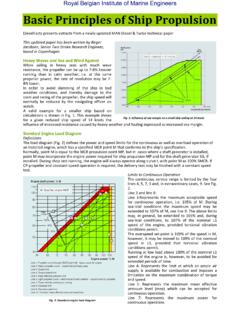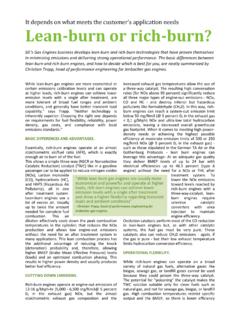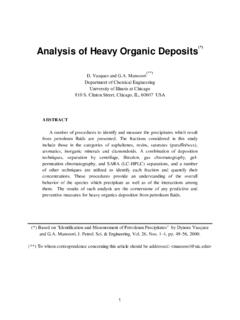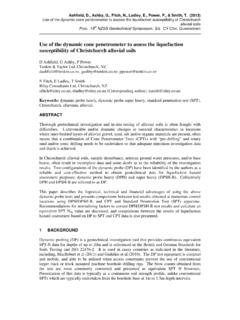Transcription of Royal Belgian Institute of Marine Engineers Detecting ...
1 Detecting asphaltenes in lube oil Fuel contamination of medium-speed engine lubricants can cause a number of problems. While the presence of nickel and vanadium in lube oil samples indicates that the contamina-tion is taking place, these elements themselves are unlikely to cause problems. The common contaminant to worry about is asphaltene-and until now it has not been possible for com-mercial services to test for it. Now ExxonMobil has come up with a means of Detecting as-phaltene contamination that s suitable for use by a high pro-duction used oil analysis service and has added the new test to those available through its Signum oil analysis service.
2 Fuel contamination can occur through leaky fuel pumps or faulty fuel injectors or as the result of poor combustion and can affect the lube oil viscosity, dilute the additives and increase the volatility of the lube oil. Detection difficulties Detection of residual or bunker fuel in heavily additized Marine engine oils is made more difficult by the fact that both the lubri-cating oil and residual fuel are hydrocarbons with similar boil-ing ranges. Several physical properties such as viscosity and pour point are similar enough and have enough variability that Detecting and measuring fuel contamination is made harder. Still, residual fuel typically has three distinguishing properties.
3 Nearly all contain asphaltenes as well as nickel and vanadium at various levels. Capitalizing on these properties provides an excellent way to detect residual fuel in used engine oils. In general, nickel and vanadium are benign contaminants. They are usually present in used Marine engine oils. Both can enter the oil by passing the piston rings as blow by or by direct con-tamination through leaky fuel pumps, etc. In unburned residual fuel, these metals are largely present in a porphyrin structure. Porphyrins are ring-like structures containing carbon, hydrogen and nitrogen. The nitrogens in porphyrins can bind to many metals, including nickel and vanadium.
4 Vanadium in residual fuel also is bound to one oxygen atom (V=O), which is the vanadyl form. When the fuel is burned, nickel and vanadium form nickel oxide (NiO) and vanadium pentoxide (V205 ). S0 the nickel and vanadium in used Marine engine oils can be a mixture of metal porphyrins and metal oxides. The ExxonMobil Residual Fuel Detection (RFD) Method meas-ures the vanadium still in the porphyrin form. This vanadium was never oxidized to vanadium pentoxide as a result of com-bustion. It remains as a vanadyl porphyrin. Therefore, the RFD test result is an indexed measure of unburned fuel contamina-tion.
5 The vanadium contaminant itself is of little concern in the lube oil. Though vanadium levels in fuel oils can vary considerably, the RFD test does act as an indicator of residual fuel components in the lube oil. Trending the results and having knowledge of the fuel in-use help to quantify the severity of contamination. Even so, vanadium is not the best fuel property to measure and neither is nickel. The best fuel oil property to measure in lube oils is asphaltenes -the molecules detrimental to the engine. asphaltenes are naturally occurring in crude oil. They are a class of organic molecules that have high molecular weight and are high boiling (600 F).
6 As a result, they concentrate in the bottom distillation fractions at refineries along with other heavy hydrocarbon molecules. These fractions are the major components in Marine fuels. There is no specification for as-phaltenes in residual fuels, but levels typically do not exceed 13 wt. %. Average levels are about 6-7 wt. %. Problems asphaltenes present two significant problems. 1) They have poor combustion properties, and 2) They can be destabilized and drop out of the oil, resulting in a tacky sludge. Both problems can affect the lubricant. This schematic shows the basic path tor asphaltenes from partial-ly burned fuel in the combustion chamber to enter the engine oil, the engine crank case, and up the pis-ton stem to the piston undercrown.
7 asphaltenes can get into engine lubricants through the same pathways as nickel and vanadium, but are not benign con-taminants. They can result in sludge formation. They can also cause the viscosity to increase, and they degrade oxidation properties of the lubricant. In addition, the presence of residual fuel, particularly asphaltenes , in the lube oil is known to pro-mote piston undercrown deposits, which can lead to piston crown burning. So, a measurement of asphaltenes in used lube oil would be a direct measure of the worst offending residual fuel contami-nant. The acceptable level of asphaltenes in engine lubricants is not when established, but wt.
8 % is generally considered high. Only rarely does the asphaltenes content reach wt. %. Most modern Marine engine lubricants are formulated to control sludge formation from fuel contamination. So, little sludge is formed in the engine now, and purifiers are unable to remove most asphaltenes from the lube oil because additives help to stabilize them. The acceptable level of asphaltenes in engine lubricants is not when established, but wt. % is generally considered high. Only rarely does the asphaltenes content reach wt. %. Most modern Marine engine lubricants are formulated to control sludge formation from fuel contamination.
9 So, little sludge Royal Belgian Institute of Marine Engineersis formed in the engine now, and purifiers are unable to remove most asphaltenes from the lube oil because additives help to stabilize them. Finding a suitable method to measure asphaltenes in used ma-rine engine lubricants has been difficult. Their typical concen-tration is too small for most potential methods to work with reasonable precision. The Central European Coordinating Council (CEC) for the devel-opment of tests for lubricants and fuels is currently near stand-ardizing a method that measures asphaltenes in used Marine engine oils with good accuracy. The method, CEC L-94, uses Gel Permeation Chromatography (GPC), also known as Size Ex-clusion Chromatography (SEC).
10 The advantage of the CEC test over the RFD test is that the most offending residual fuel component in used engine oils is measured directly. The RFD test offers an indirect method of measuring asphaltenes , since vanadium levels often trend with asphaltenes levels, but there are many exceptions. The CEC test, however, is difficult to automate for use in a com-mercial, high volume used oil analysis lab. Therefore, ExxonMo-bil Research and Engineering (EMRE) has developed a propri-etary automatable method that correlates well with CEC L-94 asphaltenes results. This new EMRE test is termed Detecting asphaltenes Contamination (DAC).
















